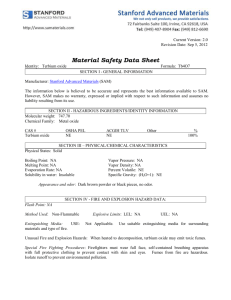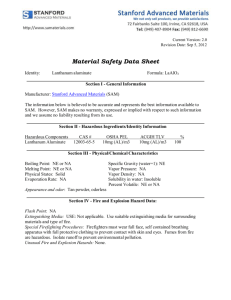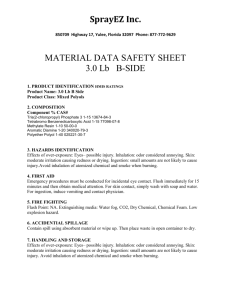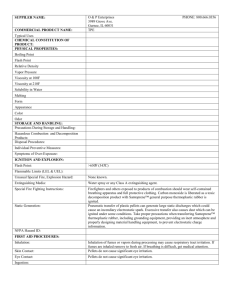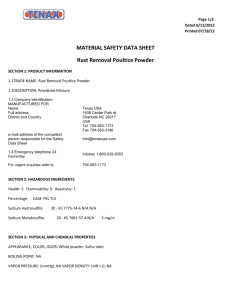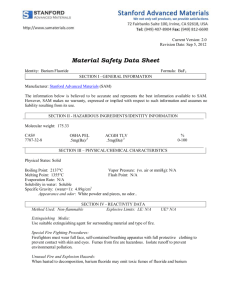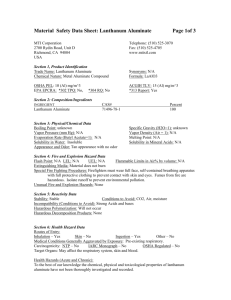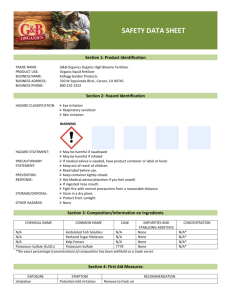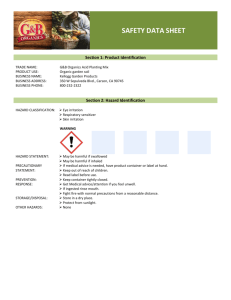Microsoft Word - Er - Stanford Advanced Materials
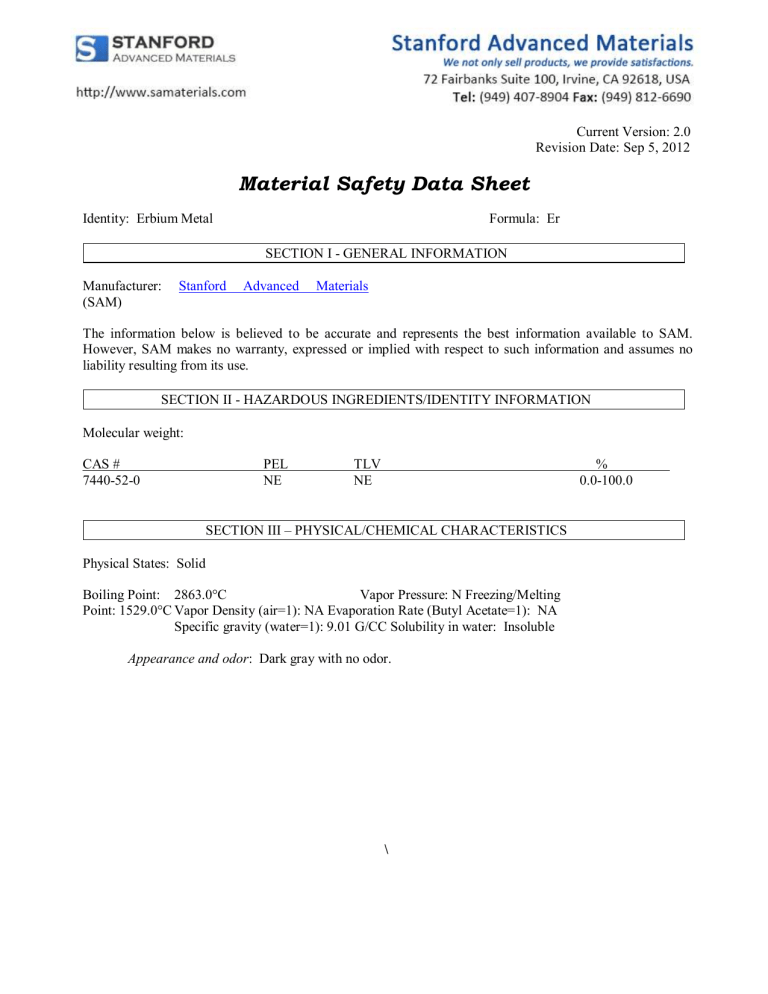
Material Safety Data Sheet
Current Version: 2.0
Revision Date: Sep 5, 2012
Identity: Erbium Metal Formula: Er
SECTION I - GENERAL INFORMATION
Manufacturer: Stanford Advanced Materials
(SAM)
The information below is believed to be accurate and represents the best information available to SAM.
However, SAM makes no warranty, expressed or implied with respect to such information and assumes no liability resulting from its use.
SECTION II - HAZARDOUS INGREDIENTS/IDENTITY INFORMATION
Molecular weight:
CAS #
7440-52-0
PEL
NE
TLV
NE
%
0.0-100.0
SECTION III – PHYSICAL/CHEMICAL CHARACTERISTICS
Physical States: Solid
Boiling Point: 2863.0°C Vapor Pressure: N Freezing/Melting
Point: 1529.0°C Vapor Density (air=1): NA Evaporation Rate (Butyl Acetate=1): NA
Specific gravity (water=1): 9.01 G/CC Solubility in water: Insoluble
Appearance and odor : Dark gray with no odor.
\
SECTION IV - FIRE AND EXPLOSION HAZARD DATA:
Flash Point/Method: NA
Fire Extinguishing Media: Use class D or other suitable metal extinguishing agent. Do not use water.
Method Used : Explosive Limits : LEL: UEL:
Extinguishing Media:
Use suitable extinguishing agent for surrounding material and type of fire.
Special Fire Fighting Procedures:
Firefighters should wear proper protective equipment and self-contained breathing apparatus with full protective clothing to prevent contact with skin and eyes. Fumes from fire are hazardous. Isolate runoff to prevent environment pollution.
Erbium metal will react with dilute acids emitting flammable/explosive hydrogen gas.
Unusual Fire and Explosion Hazards:
SECTION V – HEALTH HAZARD DATA
Routes of Entry: Ingestion, Inhalation, Eye and Skin.
To the best of our knowledge the chemical, physical and toxicological properties of erbium metal have not been thoroughly investigated and recorded.
Erbium is considered a rare earth metal. These metals are moderately, or at time, highly toxic. The symptoms of toxicity of the rate earth elements include writing, ataxia, labored respiration, and walking on the toes with arched back sedation. The rare earth elements exhibit low toxicity by ingestion exposure.
However, the intraperitoneal route is highly toxic while the subcutaneous route is poison, which is moderately toxic. The production of skin and lung granulomas after exposure to them requires extensive protection to prevent such exposure. (Sax, Dangerous Properties of Industrial Materials, eighth edition).
Inhalation – Acute: May cause irritation to the respiratory tract and mucous membrane. Dust may cause asthma attaches and lung damage such as lung granulomas. Large does may cause writhing, loss of muscle coordination, labored respiration, sedation, hypotension and cardiovascular collapse.
Chronic: Prolonged or repeated inhalation may cause writhing, loss of muscle coordination, labored respiration, sedation, hypotension and cardiovascular collapse.
Ingestion – Acute : May cause gastrointestinal irritation.
Chronic: May affect the coagulation rate of the blood.
Eye – Acute:
Chronic:
May cause irritation.
No chronic health effects recorded.
Skin – Acute :
Chronic:
May cause irritation, rashes and skin granulomas.
May cause dermatitis, sensitivity to heat, itching and skin lesions.
Target Organs: May affect the respiratory system, blood and skin
Signs and Symptoms of Exposure:
Inhalation: May cause writhing, ataxia, labored respiration, or walking on the toes with arched back and sedation.
Ingestion : May cause nausea, vomiting, diarrhea, abdominal burning and cramp-like pain.
Skin: May cause redness, itching, and burning.
Eye: May cause redness, itching, burning and watering.
Medical conditions usually aggravated by exposure: Pre-existing respiratory disorders.
Emergency and First Aid Procedures:
Inhalation: Remove victim to fresh air, keep warm and quiet, give oxygen if breathing is difficult and seek medical attention.
Ingestion: Give 1-2 glasses of milk or water and induce vomiting; seek medical attention. Never induce vomiting or anything by mouth to an unconscious person.
Skin: Remove contaminated clothing, brush material off skin; wash affected area with mild soap and water. Seek medical attention if symptoms persist.
Eye : Flush eyes with lukewarm water, lifting upper and lower eyelids, for at least 15 minutes. Seek medical attention if symptoms persist.
SECTION VI - REACTIVITY DATA
Incompatibility: Air, moisture, acids, oxidizing materials, halogens.
Hazards Decomposition products: Hydrogen gas
Conditions to Avoid : NA
Stability : Stable
Hazardous Polymerization : Will not occur.
SECTION VII - PRECAUTIONS FOR SAFE HANDLING AND USE
Steps to be taken in case material is released or spilled:
Wear appropriate respiratory and protective equipment specified in section VIII. Isolate spill area, provide ventilation and extinguish sources of ignition. Vacuum up spill using a high efficiency particulate absolute (HEPA) air filter and place in a closed container for proper disposal. Take care not to raise dust.
Waste disposal method:
Dispose of in accordance with state, local, and federal regulations.
Hazard Label Information:
Store in cool, dry area and in tightly sealed container. Wash thoroughly after handling.
SECTION VIII - CONTROL MEASURES
Protective Equipment Summary: :
NIOSH approved respirator, impervious rubber gloves, safety glasses, clothes to prevent contact.
Respiratory Protection (Specify type): N
Ventilation:
Local Exhaust: To maintain concentration at low exposure levels.
Mechanical (General): Recommended.
Special: Handle in dry, controlled atmosphere
Gloves: Rubber
Other: Protective gear to prevent contamination.
Work/Hygienic/Maintenance Practices :
Implement engineering and work practice controls to reduce and maintain concentration of exposure at low levels. Use good housekeeping and sanitation practices. Do not use tobacco or food in work area. Wash thoroughly before eating or smoking. Do not blow dust off clothing or skin with compressed air.
Please be advised that N/A can either mean Not Applicable or No Data Has Been Established
